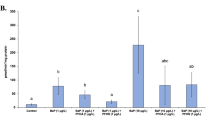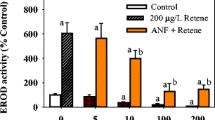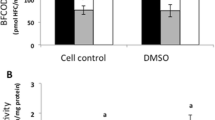Abstract
World Health Organization (WHO) toxic equivalency factors are used to calculate toxic equivalent (TEQ) concentrations of complex mixtures of dioxin-like compounds (DLCs), such as polychlorinated dibenzo-p-dioxins, polychlorinated dibenzofurans and polychlorinated biphenyls (PCBs), for mammals, fish and birds. The TEQ concept assumes that all species of a taxa respond with similar sensitivity to individual DLCs, but several reports do not support this assumption for birds. Our laboratory is conducting research to attempt to uncover the fundamental mechanism(s) underlying the reasons why avian species differ in sensitivity to DLCs. The present study determined concentration-dependent effects of 2,3,7,8-tetrachlorodibenzo-p-dioxin (TCDD), 2,3,4,7,8-pentachlorodibenzofuran (PeCDF) and 3,3′,4,4′,5-pentachlorobiphenyl (PCB 126) on ethoxyresorufin-O-deethylase (EROD) activity in primary cultures of northern bobwhite quail (Colinus virginianus) hepatocytes. Bobwhite quail were studied because (1) this species is used in the laboratory for toxicity testing and (2) the amino acids at all locations within the ligand binding domain (LBD) of aryl hydrocarbon receptor 1 (AHR1) in bobwhite quail and ring necked pheasant (Phasianus colchicus) are identical. Because earlier work indicated the importance of the identity of amino acids at key sites within the AHR1 LBD, we hypothesized that bobwhite quail and ring necked pheasant hepatocytes should have similar sensitivity to EROD induction by DLCs. ECthreshold-based relative sensitivity of the bobwhite quail compared to chicken for TCDD, PeCDF and PCB 126 was 0.11, 0.17 and 0.02, respectively. The rank order of potency was PeCDF > TCDD > PCB 126. The results confirm that bobwhite quail and ring-necked pheasant hepatocytes have similar sensitivity to EROD induction by TCDD, PeCDF and PCB 126.



Similar content being viewed by others
Notes
Correction to Hoffman et al. (1995) abstract: the correct LD50s in chicken are 0.4, 2.6, 900 and 14,000 ppb for PCBs 126, 77, 105 and 153, respectively (DJ Hoffman personal communication with SW Kennedy).
References
Cohen-Barnhouse AM, Zwiernik MJ, Link JE, Fitzgerald SD, Kennedy SW, Hervé JC, Giesy JP, Wiseman S, Yang Y, Jones PD, Wan Y, Collins B, Newsted JL, Kay D, Bursian SJ (2011) Sensitivity of Japanese quail (Coturnix japonica), common pheasant (Phasianus colchicus) and white leghorn chicken (Gallus gallus domesticus) embryos to in ovo exposure to 2,3,7,8-tetrachlorodibenzo-p-dioxin (TCDD), 2,3,4,7,8- pentachlorodibenzofuran (PeCDF) and 2,3,7,8-tetrachlorodibenzofuran (TCDF). Toxicol Sci 119:93–103
Farmahin R, Wu D, Crump D, Hervé JC, Jones SP, Hahn ME, Karchner SI, Giesy JP, Bursian SJ, Zwiernik MJ, Kennedy SW (2012) Sequence and in vitro function of chicken, ring-necked pheasant and Japanese quail AHR1 predict in vivo sensitivity to dioxins. Environ Sci Technol 46:2967–2975
Farmahin R, Crump D, Jones SP, Mundy LJ, Kennedy SW (2013a) Cytochrome P4501A induction in primary cultures of embryonic European starling hepatocytes exposed to TCDD, PeCDF and TCDF. Ecotoxicology 22:731–739
Farmahin R, Manning GE, Crump D, Wu D, Mundy LJ, Jones SP, Hahn ME, Karchner SI, Giesy JP, Bursian SJ, Zwiernik MJ, Fredricks TB, Kennedy SW (2013b) Amino acid sequence of the ligand-binding domain of the aryl hydrocarbon receptor 1 predicts sensitivity of wild birds to effects of dioxin-like compounds. Toxicol Sci 131:139–152
Hahn ME, Woodward BL, Stegeman JJ, Kennedy SW (1996) Rapid assessment of induced cytochrome P4501A protein and catalytic activity in fish hepatoma cells grown in multiwell plates: response to TCDD, TCDF, and two planar PCBS. Environ Toxicol Chem 15:582–591
Head JA, Kennedy SW (2007a) Differential expression, induction, and stability of CYP1A4 and CYP1A5 mRNA in chicken and herring gull embryo hepatocytes. Comp Biochem Physiol C 145:617–624
Head JA, Kennedy SW (2007b) Same-sample analysis of ethoxyresorufin-O-deethylase activity and cytochrome P4501A mRNA abundance in chicken embryo hepatocytes. Anal Biochem 360:294–302
Head JA, Hahn ME, Kennedy SW (2008) Key amino acids in the aryl hydrocarbon receptor predict dioxin sensitivity in avian species. Environ Sci Technol 42:7535–7541
Hervé JC, Crump D, Jones SP, Mundy LJ, Giesy JP, Zwiernik MJ, Bursian SJ, Jones PD, Wiseman SB, Wan Y, Kennedy SW (2010a) Cytochrome P4501A induction by 2,3,7,8-tetrachlorodibenzo-p-dioxin and two chlorinated dibenzofurans in primary hepatocyte cultures of three avian species. Toxicol Sci 113:380–391
Hervé JC, Crump DL, McLaren KK, Giesy JP, Zwiernik MJ, Bursian SJ, Kennedy SW (2010b) 2,3,4,7,8-Pentachlorodibenzofuran is a more potent cytochrome P4501A inducer than 2,3,7,8-tetrachlorodibenzo-p-dioxin in herring gull hepatocyte cultures. Environ Toxicol Chem 29:2088–2095
Hoffman DJ, Melancon MJ, Eisemann JD, Klein PN (1995) Comparative toxicity of planar PCB congeners by egg injection. In: Proceedings, 2nd SETAC World Congress, Vancouver, BC, Canada, November 5–9, p 207
Karchner SI, Franks DG, Kennedy SW, Hahn ME (2006) The molecular basis for differential dioxin sensitivity in birds: role of the aryl hydrocarbon receptor. Proc Natl Acad Sci USA 103:6252–6257
Kennedy SW, Lorenzen A, James CA (1993a) A rapid and sensitive cell-culture bioassay for measuring ethoxyresorufin-O-deethylase (EROD) activity in cultured-hepatocytes exposed to halogenated aromatic-hydrocarbons extracted from wild bird eggs. Chemosphere 27:367–373
Kennedy SW, Lorenzen A, James CA, Collins BT (1993b) Ethoxyresorufin-O-deethylase and porphyrin analysis in chicken embryo hepatocyte cultures with a fluorescence multiwell plate reader. Anal Biochem 211:102–112
Kennedy SW, Jones SP, Bastien LJ (1995) Efficient analysis of cytochrome P4501A catalytic activity, porphyrins, and total proteins in chicken embryo hepatocyte cultures with a fluorescence plate reader. Anal Biochem 226:362–370
Kennedy SW, Lorenzen A, Jones SP, Hahn ME, Stegeman JJ (1996) Cytochrome P4501A induction in avian hepatocyte cultures: a promising approach for predicting the sensitivity of avian species to toxic effects of halogenated aromatic hydrocarbons. Toxicol Appl Pharmacol 141:214–230
Manning GE, Farmahin R, Crump D, Jones SP, Klein J, Konstantinov A, Potter D, Kennedy SW (2012) A luciferase reporter gene assay and aryl hydrocarbon receptor 1 genotype predict the LD(50) of polychlorinated biphenyls in avian species. Toxicol Appl Pharmacol 263:390–401
Manning GE, Mundy LJ, Crump D, Jones SP, Chiu S, Klein J, Konstantinov A, Potter D, Kennedy SW (2013) Cytochrome P4501A induction in avian hepatocyte cultures exposed to polychlorinated biphenyls: comparisons with AHR1-mediated reporter gene activity and in ovo toxicity. Toxicol Appl Pharmacol 266:38–47
Mundy LJ, Jones SP, Crump D, Hervé JC, Konstantinov A, Utley F, Potter D, Kennedy SW (2010) Highly purified hexachlorobenzene induces cytochrome P4501A in primary cultures of chicken embryo hepatocytes. Toxicol Appl Pharmacol 248:185–193
OECD (2010) Report of the test method validation of the avian acute oral toxicity test (OECD Test Guideline 223). Series on testing and assessment, No. 131. Joint Meeting of the Chemicals Committee and the Working Party on Chemicals, Pesticides and Biotechnology, June 7, 2010
Petrulis JR, Bunce NJ (1999) Competitive inhibition by inducer as a confounding factor in the use of the ethoxyresorufin-O-deethylase (EROD) assay to estimate exposure to dioxin-like compounds. Toxicol Lett 105:251–260
Van den Berg M, Birnbaum L, Bosveld AT, Brunstrom B, Cook P, Feeley M, Giesy JP, Hanberg A, Hasegawa R, Kennedy SW, Kubiak T, Larsen JC, van Leeuwen FX, Liem AK, Nolt C, Peterson RE, Poellinger L, Safe S, Schrenk D, Tillitt D, Tysklind M, Younes M, Waern F, Zacharewski T (1998) Toxic equivalency factors (TEFs) for PCBs, PCDDs, PCDFs for humans and wildlife. Environ Health Perspect 106:775–792
Van den Berg M, Birnbaum LS, Denison M, De Vito M, Farland W, Feeley M, Fiedler H, Hakansson H, Hanberg A, Haws L, Rose M, Safe S, Schrenk D, Tohyama C, Tritscher A, Tuomisto J, Tysklind M, Walker N, Peterson RE (2006) The 2005 World Health Organization reevaluation of human and mammalian toxic equivalency factors for dioxins and dioxin-like compounds. Toxicol Sci 93:223–241
Villeneuve DL, Blankenship AL, Giesy JP (2000) Derivation and application of relative potency estimates based on in vitro bioassay results. Environ Toxicol Chem 19:2835–2843
Zhang R, Manning GE, Farmahin R, Crump D, Zhang X, Kennedy SW (2013) Relative potencies of aroclor mixtures derived from avian in vitro bioassays: comparisons with calculated toxic equivalents. Environ Sci Technol 47:8852–8861
Acknowledgments
This work was supported by an unrestricted grant from Georgia-Pacific LLC to the University of Ottawa and by Environment Canada’s Ecotoxicology and Wildlife Health Division. Reza Farmahin was supported by University of Ottawa scholarships and a post-doctoral fellowship.
Conflict of interest
The authors declare that there are no conflicts of interest.
Author information
Authors and Affiliations
Corresponding author
Rights and permissions
About this article
Cite this article
Jones, S.P., Farmahin, R. & Kennedy, S.W. Ethoxyresorufin-O-deethylase (EROD) induction by TCDD, PeCDF and PCB 126 in bobwhite quail hepatocytes. Ecotoxicology 23, 802–808 (2014). https://doi.org/10.1007/s10646-014-1218-6
Accepted:
Published:
Issue Date:
DOI: https://doi.org/10.1007/s10646-014-1218-6




